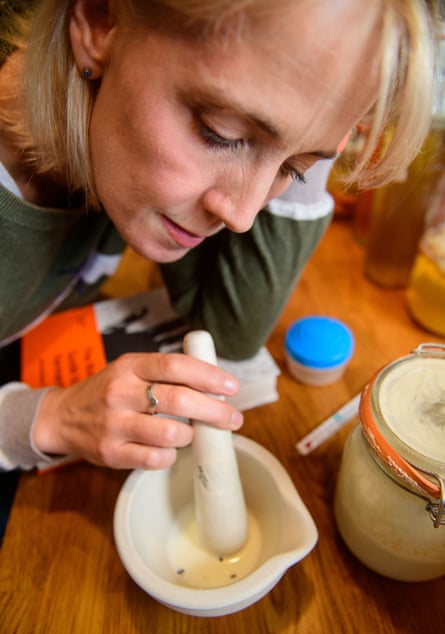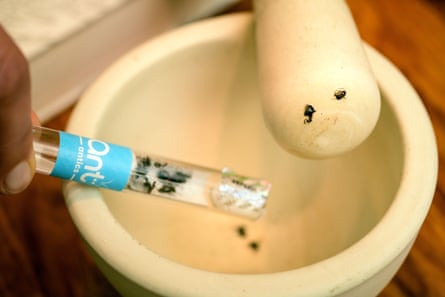PROTECT YOUR DNA WITH QUANTUM TECHNOLOGY
Orgo-Life the new way to the future Advertising by AdpathwayWhether it is kombucha, kefir, sauerkraut, kimchi, or sourdough, today’s foodies are not short of fermented treats to tantalise their tastebuds. But for the adventurous, the menu may be about to get wilder. How about a spoonful of ant yoghurt?
Making it does not involve milking any ants. Instead, the unfortunate insects are dropped into a jar of warm milk, which is tucked into an ant mound and left to ferment overnight. The fermenting tradition originating from Turkey and Bulgaria is now being resurrected in the name of science.
Dr Veronica Sinotte and her colleagues at the University of Copenhagen became interested in the practice after being approached by research and development chefs at the city’s two-Michelin-starred restaurant the Alchemist in the hope of learning more about how this fermentation process worked.
“Ants are a somewhat commonly used ingredient in high-end gastronomy in Copenhagen. They’re an ingredient chefs like to play with,” said Dr Leonie Jahn, a senior researcher at the Novo Nordisk Foundation Centre for Biosustainability in Lyngby, who supervised the project.
“The [former] head of Alchemist’s R&D was very keen on science-driven food innovation and quite excited about the acidity of the ants. He wanted to explore that.”

But was it the ants’ formic acid that turned the milk into yoghurt, or something else?
To investigate, the researchers visited a village in southern Bulgaria, where a co-author of the research, Sevgi Sirakova, had family ties. Though the villagers no longer made ant yoghurt themselves, some remembered older generations’ methods and helped reconstruct a makeshift recipe: milk a cow, warm the milk until it “bites” your finger, add four red wood ants, cover with cheesecloth and bury the pot in an ant mound overnight. The mound provides warmth, and possibly additional microbes that fall in through the cheesecloth.
The next day, Sinotte sampled the results: “It was at this early stage of a nice yoghurt – fermentation was dropping the acidity and there were some tiny flavours and herbaceous notes.”
Back in the laboratory, the team ran further experiments under controlled conditions, using a related red wood ant found in Denmark. According to Sinotte, this yoghurt tasted a little different – it was thicker, with more lemony notes – perhaps because of differences in the quantity and composition of the ant starter culture.
Their findings, which are published in the journal iScience, suggest the fermentation is a collaborative process between ant and microbe: the insects’ formic acid lowers the milk’s pH, enabling their acid-loving microbes to thrive, while ant or bacterial enzymes break down milk proteins to produce a yoghurt. Notably, only live ants had the correct microbial community.

As a keen “fermentista”, I found the urge to try making my own ant yoghurt hard to resist. Sinotte and colleagues advise against this: some ants can carry a parasite, a type of liver fluke that is harmful to humans. Plus, red wood ant numbers are declining across wide parts of Europe, making large-scale harvesting of the insect unsustainable.
I spent a good hour fretting over the ethics, but curiosity won out – helped by finding a supplier that funds red wood ant reintroductions. With a relative experienced in ant-keeping to care for my remaining colony, I also hoped to offset the loss of the four ants I planned to sacrifice.
Adapting the methodology from Sinotte’s iScience paper, I sterilised a pestle and mortar, heated 30ml of milk to 42C, added four crushed ants, then strained the mixture through a microbiology-grade sieve to remove any parasites or ant fragments, before incubating it in my regular yoghurt maker overnight.
The result was a gelatinous yoghurt, with a surprisingly creamy taste. I did not detect any lemony notes, just a mild bitterness. It was actually rather nice.
Curiosity aside, such experiments could give rise to practical applications. The researchers believe microbes from ants could serve as a toolkit for creating new foods such as plant-based yoghurts, or introducing novel flavours to existing ones such as sourdough.
Prof Martin Blaser, a human microbiome expert at Rutgers University in the US, said he was excited by the research. “One consequence of the worldwide popularity of yoghurt is that there are a few industrial strains [of bacteria] that dominate yoghurt making,” he said.
“Nutritionally, my guess is that ant yoghurt is more or less equivalent to industrially produced yoghurt. But for the discerning, this kind of approach could possibly broaden our repertoire of foods, giving us interesting and unique tastes.”
Ants are not the only unusual ingredient historically used to make yoghurt. In Turkey and other countries, people have traditionally used plant material such as pinecones, chamomile and linden flowers, or nettle roots to kickstart yoghurt fermentations. Investigating these approaches could impart further textures or flavours – with the added benefit of leaving ants unharmed. Nettle yoghurt for breakfast, anyone?


 6 hours ago
1
6 hours ago
1





















 English (US) ·
English (US) ·  French (CA) ·
French (CA) ·